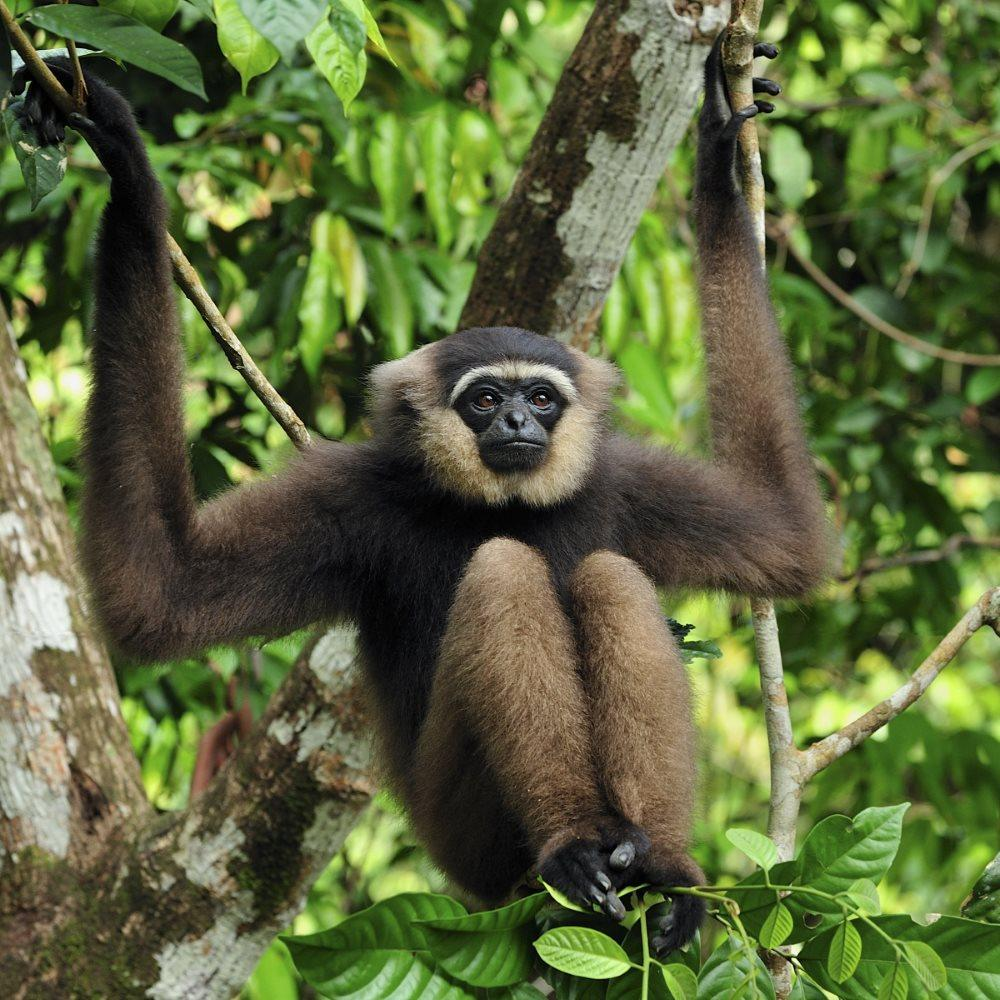Important Facts For Prelims
Hollongapar Gibbon Sanctuary
- 04 Sep 2023
- 5 min read
Why in News?
Primatologists have suggested rerouting a 1.65-km-long railway track that has divided the Hollongapar Gibbon Sanctuary, in eastern Assam dedicated to the western hoolock gibbon into two unequal parts.
What are the Key Facts About Hoolock Gibbons?
- About:
- Hoolock Gibbons, known as the smallest and fastest of all apes, inhabit tropical and subtropical forests in Southeast Asia.
- They have high intelligence, distinct personalities, and strong family bonds similar to other apes.
- They represent one of the 20 gibbon species found worldwide.
- Hoolock Gibbons are India's only ape species.
- Gibbon Species in India:
- Western Hoolock Gibbon (Hoolock hoolock):
- It inhibits in all the states of the north-east, restricted between the south of the Brahmaputra River and east of the Dibang River. Outside India, it is found in eastern Bangladesh and north-west Myanmar.
- International Union for Conservation of Nature's Red List (IUCN): Endangered
- Eastern Hoolock Gibbon (Hoolock leuconedys):
- It inhabits specific pockets of Arunachal Pradesh and Assam in India, and in southern China and north-east Myanmar outside India.
- IUCN Red List: Vulnerable
- In India, both species are listed on Schedule 1 of the Indian (Wildlife) Protection Act 1972.
- Western Hoolock Gibbon (Hoolock hoolock):
- Characteristics:
- They are known for their distinct white eyebrows, long arms, and a throat sac used for vocalizations.
- Arboreal Lifestyle:
- Gibbons are exclusively arboreal, spending their lives in the treetops of tropical forests.
- Challenges:
- Hoolock gibbons are particularly sensitive to habitat disruptions, such as canopy gaps.
- Fragmentation of their habitat can lead to genetic isolation and threaten their populations.
- Conservation Efforts:
- Initiatives like artificial canopy bridges aim to facilitate their movement and preserve genetic diversity.
- Gibbons play a vital role in forest ecosystems by dispersing seeds as they travel through the canopy.
- Their conservation is essential for maintaining the health and biodiversity of their habitats.
Gibbon Sanctuary:
- Hoollongapar Gibbon Sanctuary, formerly known as Gibbon Wildlife Sanctuary, is located in Assam's Jorhat district, India.
- Established in 1997, it boasts a rich biodiversity, housing India's only gibbons, the western Hoolock hoolock, and the Bengal slow loris, the sole nocturnal primate in Northeastern India.
UPSC Civil Services Examination, Previous Year Questions (PYQs)
Q. Consider the following pairs: (2010)
| Protected area | Well-known for |
| Bhiterkanika, Orissa | Salt Water Crocodile |
| Desert National Park, Rajasthan | Great Indian Bustard |
| Eravikulam, Kerala | Hoolock Gibbon |
Which of the pairs given above is/are correctly matched?
(a) 1 only
(b) 1 and 2 only
(c) 2 only
(d) 1, 2 and 3
Ans: (b)
Q. Among the following, which one is not an ape? (2008)
(a) Gibbon
(b) Gorilla
(c) Langur
(d) Orangutan
Ans: C
- Apes (Hominoidea) are a branch of Old World tailless simians native to Africa and Southeast Asia. They are divided into Greater Apes and Lesser Apes. The Greater Apes family is Hominidae, with subfamily comprising of gorillas, hominoids and chimps, whereas Lesser Apes belong to family of Hylobatidae.
- For example, Bonobos, Pygmy Chimpanzee, Gibbon, Orangutan etc.
- Monkeys and apes are both primates, which means they both are parts of the human family tree. The quickest way to tell the difference between a monkey and an ape is by the presence or absence of a tail. Almost all monkeys have tails, but apes do not.
- Their bodies are different in other ways too – monkeys are generally smaller and narrow-chested, while apes are larger and have broad chests and shoulder joints that allow them to swing through trees.
- Gray langurs or Indian langurs are a group of Old World monkeys native to the Indian subcontinent constituting the entirety of the genus Semnopithecus. Gray langurs are fairly terrestrial, inhabiting forests, open light wooded habitats, and urban areas of the Indian subcontinent.
- Most species are found at low to moderate altitudes, but the Nepal gray langur and Kashmir gray langur are found up to 4,000 m in the Himalayas.
- Therefore, option (c) is the correct answer.







